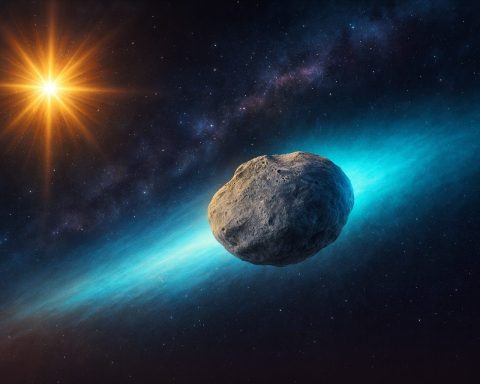On 24 November 2025, interstellar comet 3I/ATLAS is at the center of one of the noisiest space-news cycles in years. In the last 24 hours we’ve had:
- NASA’s long‑awaited Mars-based images of the comet finally go public
- A new analysis of its strange, tightly collimated jets
- Fresh speculation about alien technology and “motherships”
- Confirmation from multiple observatories that, despite the drama, it still behaves like a natural comet
- And in the background, a different “ATLAS” comet in our own Solar System is literally breaking apart
Here’s a full, Google-News-friendly rundown of everything that matters about 3I/ATLAS today, 24 November 2025 — plus how and where you can try to see it.
1. Quick snapshot: What’s new about 3I/ATLAS today?
Several key updates dated or reported on 24 November 2025:
- NASA’s Mars images released: After delays caused by the US government shutdown, NASA has released close-up images of 3I/ATLAS from the Mars Reconnaissance Orbiter (MRO), the MAVEN orbiter, and the Perseverance rover. These data show the comet’s coma and hydrogen cloud in fine detail and will refine estimates of its size and composition. [1]
- Heliophysics fleet tracks the comet near the Sun: A new Sci.News article describes how STEREO, SOHO and PUNCH combined stacked images to follow the comet as it passed behind the Sun from Earth’s point of view, confirming its speed (about 209,000 km/h) and revealing a faint but definite tail. [2]
- Earth distance & trajectory update: A News.az report (24 Nov, 22:47) says 3I/ATLAS passed within 300 million km of Earth on the morning of 23 November and is drawing closer by about 2 million km per day, on track for a closest approach on 19 December 2025 at ~269 million km (≈1.8 AU) — a fully safe distance. [3]
- Jet “anomalies” and missing classic tail: A USA Herald feature (24 Nov) highlights recent images showing multiple narrow jets, a strong forward-facing “anti-tail” and an unexpectedly weak traditional dust tail, calling the comet’s morphology “unprecedented” and puzzling for standard comet physics. [4]
- Alien speculation vs. NASA verdict: New essays by Harvard astrophysicist Avi Loeb lay out a list of statistical and physical “anomalies” and explore exotic possibilities. But NASA’s 19 Nov press conference and coverage in WIRED and other outlets stressed that all available data are consistent with a natural interstellar comet, and that 3I/ATLAS poses no threat to Earth. [5]
- The “other” ATLAS comet is disintegrating: Parallel coverage today and yesterday tracks Comet C/2025 K1 (ATLAS) — a completely different object — breaking into multiple fragments after its close solar pass, including mentions in India Today, IFLScience and a Live Science daily news rundown. TechStock²+2Live Science+2
So: the science is getting sharper, the images are getting better, and the headlines are getting wilder — but the collision risk remains zero.
2. What exactly is 3I/ATLAS – and where is it today?
3I/ATLAS (C/2025 N1) is only the third confirmed interstellar object ever seen in our Solar System, after 1I/ʻOumuamua (2017) and 2I/Borisov (2019). It was first reported on 1 July 2025 by the NASA‑funded ATLAS survey telescope in Chile. [6]
Key facts as of 24 November 2025 (based on ephemerides compiled from TheSkyLive and recent observing notes):
- Orbit type: Hyperbolic, clearly unbound to the Sun — it will leave the Solar System and never return. [7]
- Perihelion: Passed closest to the Sun on 29–30 October 2025 at about 1.36 AU, just inside Mars’ orbit. TechStock²+1
- Current distance: Around 1.9–2.0 AU from Earth (~295–300 million km), having just crossed the 300‑million‑km mark on 23 November. [8]
- Brightness: About magnitude 10–11 — far too faint for the naked eye, but reachable with modest telescopes under dark skies. TechStock²+1
- Position in the sky tonight: In the constellation Virgo, roughly a couple of degrees above the star Porrima (γ Virginis) in the pre‑dawn sky for mid‑northern latitudes. TechStock²+1
- Closest approach to Earth: Expected on 19 December 2025, at roughly 1.8 AU (≈267–270 million km). [9]
In other words: 3I/ATLAS is a distant, faint visitor speeding through the inner Solar System — scientifically exciting, but physically harmless.
3. NASA’s Mars spacecraft finally show us 3I/ATLAS up close
One of today’s biggest developments is the broad circulation of NASA’s Mars-based observations, following both NASA’s own feature story and Universe Today’s coverage, which went live in the early hours of 24 November. [10]
Three different views from Mars
In early October, as 3I/ATLAS swept past Mars at about 30 million km, three NASA missions grabbed a rare, close look: [11]
- Mars Reconnaissance Orbiter (MRO – HiRISE camera)
- Rotated off the Martian surface to target the comet directly.
- Captured a compact coma about 1,500 km across, allowing better constraints on the size of the solid nucleus.
- At the time of imaging, the comet was about 0.2 AU (18.6 million miles / ~30 million km) from the spacecraft. [12]
- MAVEN (Imaging Ultraviolet Spectrograph, IUVS)
- Took multi-wavelength UV images over ten days (27 Sept–7 Oct).
- Mapped hydrogen atoms around the comet and separated them from hydrogen in Mars’ atmosphere and the interplanetary medium.
- Provided an upper limit on the deuterium-to-hydrogen ratio, a key tracer of where and how the comet formed in its original stellar system. [13]
- Perseverance rover (Mastcam-Z)
- From Jezero Crater, took long-exposure images where stars appear as streaks and 3I/ATLAS is a faint moving smudge.
- Demonstrates just how subtle the comet is even in long exposures from the Martian surface. [14]
Together, these data sets give scientists a kind of multi-layer CAT scan of the interstellar visitor: visible-light size and structure from MRO, ultraviolet gas chemistry from MAVEN, and ground-truth imaging from Perseverance.
NASA emphasises that observations of interstellar objects are still rare enough that “we learn something new on every occasion”, and 3I/ATLAS is no exception. [15]
4. Heliophysics spacecraft track the comet around the Sun
While Mars spacecraft watched 3I/ATLAS from the side, three heliophysics missions watched it as it slipped past the Sun from our perspective.
A Sci.News article released today details how: [16]
- STEREO-A observed the comet from 11 September to 2 October 2025, using its Heliospheric Imager-1. The comet was initially too faint to see in single frames, but stacking multiple exposures pulled it out as a small brightening moving across the field.
- SOHO (ESA/NASA) caught 3I/ATLAS between 15–26 October, about 358 million km from the spacecraft, again visible only after careful image stacking, showing just how faint the object is near solar elongations. [17]
- PUNCH observed between 20 September and 3 October, revealing a short but distinct tail as a slight elongation to the lower right once images were stacked. [18]
These heliophysics missions are designed to watch solar wind and the Sun’s corona, not comets — so the fact that they can still tease out 3I/ATLAS with clever processing is a bonus for comet science.
5. Jet “anomalies” and the strange tail of 3I/ATLAS
If there’s one thing fuelling today’s more speculative headlines, it’s the comet’s unusual jet and tail structure.
A detailed USA Herald piece dated 24 November highlights images taken on 22 November (and other recent data) that show: [19]
- A bright, compact nucleus instead of a large, diffuse coma
- Bilateral gas emissions on either side of the core
- A persistent sunward “anti-tail”, extending in roughly the direction of motion / toward the Sun
- Multiple narrow, collimated jets extending millions of kilometers, rather than the broad, fuzzy tails typical of many comets
- An apparently weak or absent classic dust tail, despite estimates that the comet has shed a large fraction of its mass near perihelion
The article notes that, if current mass-loss estimates are correct, 3I/ATLAS should be surrounded by a huge, easily visible tail, yet images show mostly narrow jets and anti-tails. It also points to unusual chemical ratios (like nickel vs. certain carbon-bearing molecules) and a nearly spherical unresolved core as further puzzles. [20]
Mainstream comet scientists are actively exploring natural explanations, including:
- Unusual composition for an interstellar object (e.g., different volatile mix compared with Solar System comets)
- Localized vents on the surface that fire narrow jets
- Complex rotation that causes jets to sweep out strange patterns
- Large dust grains or chunks whose dynamics differ from fine dust
None of these possibilities require alien engineering, but they do underline how poorly we understand interstellar comet physics when we only have three examples.
6. Radio signal & NASA’s verdict: overwhelming evidence for a natural comet
The more dramatic the images look, the more crucial it is to ask: what do the measurements say?
MeerKAT’s “radio signal”
On 10 November, WIRED reported the first radio detection from 3I/ATLAS by South Africa’s MeerKAT telescope — not a techno-beacon, but hydroxyl (OH) absorption lines at 1665 and 1667 MHz. These lines are textbook markers of cometary water being broken apart by sunlight. [21]
In other words: the radio signature matches ordinary outgassing chemistry, not an artificial transmitter.
NASA’s 19 Nov press conference
On 19 November, NASA held a press event to showcase its multi-mission data set. Coverage in WIRED (and other outlets) summarised the conclusion bluntly: 3I/ATLAS is an interstellar comet, not alien hardware. [22]
The case for a natural comet now rests on multiple, independent lines of evidence:
- Hyperbolic orbit consistent with an unbound interstellar object. [23]
- Multi-wavelength imaging (Hubble, JWST, Mars spacecraft, STEREO, SOHO, PUNCH) showing a coma and jets powered by solar heating. [24]
- Ultraviolet detections of hydrogen and hydroxyl from sublimating water ice. [25]
- Radio OH absorption from MeerKAT consistent with cometary outgassing. [26]
Is every anomaly solved? No. But the default explanation — a very weird natural interstellar comet — fits the data far better than any engineered object hypothesis at this stage.
7. The alien “mothership” debate, Loeb’s new essay and tabloid spin
Of course, 3I/ATLAS is not just a scientific story; it’s also a cultural one.
What Avi Loeb is actually arguing
In a new Medium essay this month, Harvard astrophysicist Avi Loeb lists a set of “anomalies” in 3I/ATLAS’s behaviour: unusual brightness evolution, anti-tail geometry, mass-loss estimates, color changes, and aspects of its trajectory (including a future close pass to Jupiter’s Hill sphere on 16 March 2026). He suggests that, taken together, these features are statistically unlikely for a random natural object and merit “technological” hypotheses being kept on the table. [27]
Loeb is not claiming proof of alien origin; he’s arguing for open-minded scrutiny until more data arrive. That nuance often disappears in headlines.
How it’s being reported today
- Some outlets, including tabloids, have run with phrases like “mothership” or claim the comet could be “dispatching probes to spy on Jupiter,” citing Loeb’s interest in the Jupiter encounter and speculative scenarios. [28]
- At the same time, NASA’s press event and follow-up Q&As emphasise caution about over-interpreting anomalies, framing them as opportunities to refine models of outgassing, composition and rotation rather than evidence of technology. [29]
For now, the consensus in the planetary-science community is that:
- 3I/ATLAS is almost certainly natural,
- but unusually informative precisely because it stretches our comet models in uncomfortable ways.
That’s good science territory, even without aliens.
8. The “other” ATLAS comet that really is breaking apart
Adding to the confusion, a different comet — C/2025 K1 (ATLAS) — is also all over today’s news.
Key points:
- C/2025 K1 is a Solar System comet, not interstellar.
- After a very close solar pass in October, it turned a striking golden colour, likely due to its peculiar chemistry. TechStock²+1
- High‑resolution images in mid-November showed the nucleus splintering into several bright fragments. Space.com, IFLScience and others have reported that K1 is disintegrating in real time, and today’s Live Science daily feed lists the “other comet ATLAS” as disintegrating after breaking apart. [30]
This is not 3I/ATLAS, but the name overlap (“ATLAS” is the survey that finds many comets) is driving a lot of social-media confusion. When you see headlines about a comet “falling to pieces”, check whether it says C/2025 K1 or 3I/ATLAS — they’re different stories.
9. How to see 3I/ATLAS tonight (24 November 2025)
Even with all this coverage, 3I/ATLAS is not a naked-eye spectacle. But if you have a telescope and reasonably dark skies, you may be able to track it down.
Based on ephemerides cited by TheSkyLive and observing guides published today by TechStock² / TS2: TechStock²+2TechStock²+2
Visibility basics (mid‑northern latitudes, ~30–55° N)
- When:
- Look before dawn on 24/25 November, roughly 2–3 hours before sunrise.
- Where:
- In Virgo, about 2° above the star Porrima (γ Virginis).
- How bright:
- Around magnitude 10–11. Think small fuzzy star in a telescope, not a dramatic sky-sweeping tail.
- What you need:
- At minimum, large binoculars (e.g. 15×70) in excellent conditions, but realistically a small telescope (80–100 mm refractor or 6–8″ reflector) is recommended.
Practical observing tips
- Use an up-to-date star chart or app
- Plug in “3I/ATLAS” or “C/2025 N1” to get the latest coordinates for your location and time.
- Start with Porrima
- Porrima is a bright star in Virgo; once you’ve centered it in a low-power eyepiece, nudge your telescope a couple of degrees toward the predicted comet position.
- Look for motion, not drama
- Over 30–60 minutes, you may see the comet’s fuzzy point shift slightly against the background stars — a subtle but satisfying confirmation that you’re really tracking an interstellar visitor.
- Manage expectations
- The most spectacular 3I/ATLAS images you’ve seen online are from long exposures and heavy processing. At the eyepiece, expect something quiet and ghostly rather than Instagram-level fireworks.
Meanwhile, brighter comets like C/2025 A6 (Lemmon) are easier targets (around magnitude 5.2 in evening twilight), and the shattered C/2025 K1 (ATLAS) remains a rewarding telescopic object in Ursa Major. TechStock²+1
10. What happens next: Earth flyby, Jupiter encounter and beyond
Looking ahead:
- 19 December 2025 – Closest approach to Earth
- Distance: roughly 1.8 AU (~267–270 million km).
- Multiple sources, including NASA and News.az, stress that this is entirely safe — about 700 times the Earth–Moon distance. [31]
- 16 March 2026 – Close pass by Jupiter
- 3I/ATLAS is expected to pass within roughly 50–55 million km of Jupiter, near the edge of the planet’s Hill sphere, potentially allowing instruments like Juno to gather additional data. [32]
- After 2026 – Outbound into interstellar space
- With a hyperbolic orbit and a maximum speed at perihelion above 68 km/s, 3I/ATLAS will gradually fade and head back into the dark between the stars, never to return. [33]
Between now and then, astronomers will continue to:
- Refine nucleus size and shape from Mars and heliophysics imagery
- Analyze jet composition and dynamics
- Track how its brightness, color and tail evolve as it recedes from the Sun
The more it surprises us, the more we learn — whether every anomaly ends up with a mundane explanation or we ultimately discover that interstellar comets can be even stranger than we thought.
Bottom line for 24 November 2025
- 3I/ATLAS remains a faint but fascinating interstellar comet, currently about 300 million km from Earth and creeping closer each day. [34]
- Today’s big science story is the release and amplification of Mars-based images and heliophysics observations, which deepen our understanding of its size, composition and environment. [35]
- New analyses of its jets and tail highlight unsolved puzzles, but current measurements — including OH radio lines and multi-wavelength imaging — strongly support a natural origin. [36]
- Speculation about “motherships” and “probes” makes for eye-catching headlines, yet remains hypothetical and is not backed by the mainstream data interpretation. [37]
- If you have a telescope and a clear pre-dawn sky, you can join the global observing campaign tonight and catch a tiny, interstellar smudge on its one and only visit.
References
1. www.nasa.gov, 2. www.sci.news, 3. news.az, 4. usaherald.com, 5. www.wired.com, 6. science.nasa.gov, 7. science.nasa.gov, 8. news.az, 9. news.az, 10. www.nasa.gov, 11. www.nasa.gov, 12. www.nasa.gov, 13. www.nasa.gov, 14. www.nasa.gov, 15. www.nasa.gov, 16. www.sci.news, 17. science.nasa.gov, 18. www.sci.news, 19. usaherald.com, 20. usaherald.com, 21. www.wired.com, 22. www.wired.com, 23. en.wikipedia.org, 24. science.nasa.gov, 25. www.nasa.gov, 26. www.wired.com, 27. avi-loeb.medium.com, 28. usaherald.com, 29. www.wired.com, 30. www.livescience.com, 31. news.az, 32. usaherald.com, 33. en.wikipedia.org, 34. news.az, 35. www.nasa.gov, 36. usaherald.com, 37. avi-loeb.medium.com










